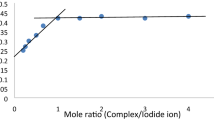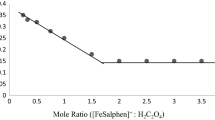Abstract
The kinetics of the oxidation of promazine by trisoxalatocobaltate(III) were studied in the presence of a large excess of the cobalt(III) in tris buffer solution using u.v.–vis spectroscopy ([CoIII] = (0.6 − 2) × 10−3 M, [ptz] = 6 × 10−5 M, pH = 6.6–7.8, I = 0.1 M (NaCl), T = 288−308 K, l = 1 cm). The reaction proceeds via two consecutive reversible steps. In the first step, the reaction leads to formation of cobalt(II) species and a stable cationic radical. In the second step, cobalt(III) is reduced to cobalt(II) ion and a promazine radical is oxidized to the promazine 5-oxide. Linear dependences of the pseudo-first-order rate constants (k 1 and k 2) on [CoIII] with a non-zero intercept were established for both redox processes. Rates of reactions decreased with increasing concentration of the H+ ion indicating that the promazine and its radical exist in equilibrium with their deprotonated forms, which are reactive reducing species. The activation parameters for reactions studied were as follows: ΔH≠ = 44 ± 1 kJ mol−1, ΔS≠ = −100 ± 4 JK−1 mol−1 for the first step and ΔH≠ = 25 ± 1 kJ mol−1, ΔS≠ = −169 ± 4 J K−1 mol−1 for the second step, respectively. Mechanistic consequences of all the results are discussed.
Similar content being viewed by others
References
H. Lüllmann, K. Mohr, A. Ziegler and D. Bieger, Color Atlas of Pharmacology, 2nd edit., Thieme, Stuttgart, 2000, p. 236.
R.D. Cannon and J.S. Stillman, J. Chem. Soc., Dalton Trans., 428 (1976).
M. Kimura, M. Yamamoto and S. Yarnabe, J. Chem. Soc., Dalton Trans., 423 (1982).
Martinez P., Zuluaga J. and Kraft J. (1988). Inorg. Chim. Acta 146: 9
J. Macyk and R. van Eldik, J. Chem. Soc., Dalton Trans., 2288 (2001).
Z. Yang and E. Gould, J. Chem. Soc., Dalton Trans., 3601 (2004).
Shriver D.F. and Atkins P.W. (1999). Inorganic Chemistry. Oxford University Press, Oxford, 693–714
J.A. Broomhead, I. Lauder and P. Nimmo, J. Chem. Soc. A, 645 (1971).
J. Aggett and A. L. Odell, J. Chem. Soc. A, 1415 (1968).
Bailar J.C. and Jones J.E.M. (1939). Inorg. Synth. 1: 35
Siebert H. (1959). Z. Anorg. Allg. Chem. 298: 51
Tanaka N. and Shimura Y. (1967). Bull. Chem. Soc. Jpn. 40: 330
Fujita J. and Shimura Y. (1963). Bull. Chem. Soc. Jpn. 36: 1281
A. Mead, J. Phys. Chem., 1052 (1934).
Pelizzetti E. and Mentasti E. (1979). Inorg. Chem. 18: 583
Wilkins R.G. (1991). Kinetics and Mechanism of Reactions of Transition Metal Complexes. VCH, Weinheim, 18–21
Ortiz A., Poyato I. and Fernandez-Alonso J.I. (1983). J. Pharm. Sci 72: 50 apart from that molar absorption coefficients are incorrect
Merkle F.H. and Discher C.A. (1964). Anal. Chem. 36: 1639
Weast R.C. (2000). CRC Handbook of Chemistry and Physics. 1st Student Edit, CRC Press, Boca Raton, Florida, D-102
Hulshoff A. and Perrin J. (1976). Pharm. Acta Helv. 51: 65
Lappin A.G. (1980). Redox Mechanism in Inorganic Chemistry. Ellis Horwood, New York, 75
Warren R.M.L., Lappin A.G. and Tatehata A. (1992). Inorg. Chem. 31: 566
J.O. Ehighaokhuo, J. F. Ojo and O. Olubuyide, J. Chem. Soc., Dalton Trans., 1665 (1985).
Author information
Authors and Affiliations
Corresponding author
Rights and permissions
About this article
Cite this article
Wiśniewska, J. Kinetic study of the promazine oxidation to promazine 5-oxide by trisoxalatocobaltate(III) in basic aqueous media. Transition Met Chem 32, 107–111 (2007). https://doi.org/10.1007/s11243-006-0130-1
Received:
Accepted:
Published:
Issue Date:
DOI: https://doi.org/10.1007/s11243-006-0130-1




